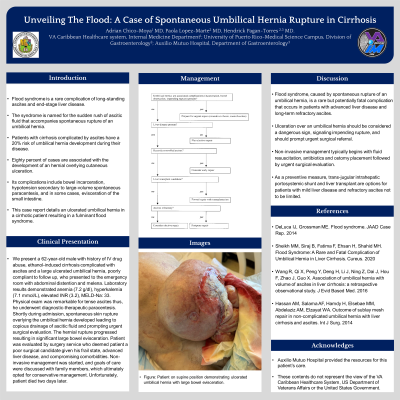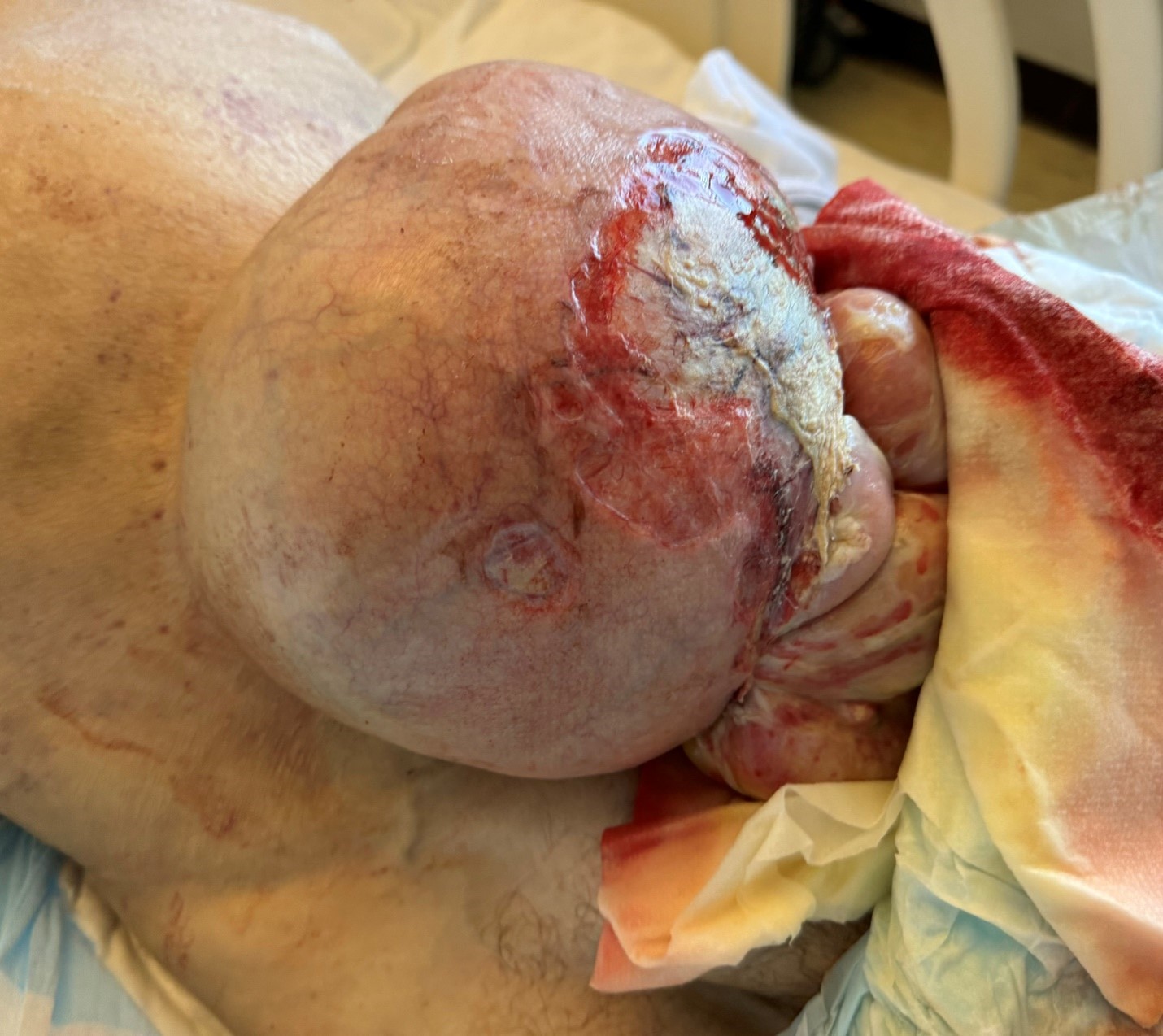Tuesday Poster Session
Category: Liver
P4697 - Unveiling The Flood: A Case of Spontaneous Umbilical Hernia Rupture in Cirrhosis
Tuesday, October 29, 2024
10:30 AM - 4:00 PM ET
Location: Exhibit Hall E

Has Audio

Adrian R. Chico, MD
VA Caribbean Healthcare System
San Juan, PR
Presenting Author(s)
Adrian R.. Chico Moya, MD1, Paola Lopez-Marte, MD2, Hendrick Pagan-Torres, MD3
1VA Caribbean Healthcare System, San Juan, Puerto Rico; 2University of Puerto Rico, Medical Sciences Campus, San Juan, Puerto Rico; 3Auxilio Mutuo Hospital, San Juan, Puerto Rico
Introduction: Flood syndrome is a rare complication of long-standing ascites and end-stage liver disease consisting of spontaneous umbilical hernia rupture accompanied with sudden rush of ascitic fluid. Eighty percent of cases are associated with the development of an hernial overlying cutaneous ulceration. Its complications include bowel incarceration, hypotension secondary to large-volume spontaneous paracentesis, and in some cases, evisceration of the small intestine. This case report details an ulcerated umbilical hernia resulting in a fulminant flood syndrome.
Case Description/Methods: We present a 62-year-old Male with history of ethanol-induced cirrhosis complicated with ascites and ulcerated umbilical hernia, poorly compliant to follow up, who presented to the emergency room with abdominal distention and melena. Laboratory results demonstrated anemia (7.2 g/dl), hyperkalemia (7.1 mmol/L), elevated INR (3.2), MELD-Na: 33. Physical exam was remarkable for tense ascites thus, he underwent diagnostic-therapeutic paracentesis. Shortly during admission, spontaneous skin rupture overlying the umbilical hernia developed leading to copious drainage of ascitic fluid and prompting urgent surgical evaluation. The hernial rupture progressed resulting in significant large bowel evisceration. Patient was evaluated by surgery service who deemed patient a poor surgical candidate given his advanced liver disease, and compromising comorbidities. Non-invasive management was started, and goals of care were discussed with family members, which ultimately opted for conservative management. Unfortunately, patient died two days later.
Discussion: Flood syndrome, caused by spontaneous rupture of an umbilical hernia, is a rare but potentially fatal complication that occurs in patients with advanced liver disease and long-term refractory ascites. Ulceration over an umbilical hernia should be considered a dangerous sign, signaling impending rupture, and should prompt urgent surgical referral. Non-invasive management typically begins with fluid resuscitation, antibiotics and ostomy placement followed by urgent surgical evaluation. Nevertheless, once the disease develops it’s associated with a high post-surgical morbidity and mortality rate. As a preventive measure, trans-jugular intrahepatic portosystemic shunt and liver transplant are options for patients with mild liver disease and refractory ascites.

Disclosures:
Adrian R.. Chico Moya, MD1, Paola Lopez-Marte, MD2, Hendrick Pagan-Torres, MD3. P4697 - Unveiling The Flood: A Case of Spontaneous Umbilical Hernia Rupture in Cirrhosis, ACG 2024 Annual Scientific Meeting Abstracts. Philadelphia, PA: American College of Gastroenterology.
1VA Caribbean Healthcare System, San Juan, Puerto Rico; 2University of Puerto Rico, Medical Sciences Campus, San Juan, Puerto Rico; 3Auxilio Mutuo Hospital, San Juan, Puerto Rico
Introduction: Flood syndrome is a rare complication of long-standing ascites and end-stage liver disease consisting of spontaneous umbilical hernia rupture accompanied with sudden rush of ascitic fluid. Eighty percent of cases are associated with the development of an hernial overlying cutaneous ulceration. Its complications include bowel incarceration, hypotension secondary to large-volume spontaneous paracentesis, and in some cases, evisceration of the small intestine. This case report details an ulcerated umbilical hernia resulting in a fulminant flood syndrome.
Case Description/Methods: We present a 62-year-old Male with history of ethanol-induced cirrhosis complicated with ascites and ulcerated umbilical hernia, poorly compliant to follow up, who presented to the emergency room with abdominal distention and melena. Laboratory results demonstrated anemia (7.2 g/dl), hyperkalemia (7.1 mmol/L), elevated INR (3.2), MELD-Na: 33. Physical exam was remarkable for tense ascites thus, he underwent diagnostic-therapeutic paracentesis. Shortly during admission, spontaneous skin rupture overlying the umbilical hernia developed leading to copious drainage of ascitic fluid and prompting urgent surgical evaluation. The hernial rupture progressed resulting in significant large bowel evisceration. Patient was evaluated by surgery service who deemed patient a poor surgical candidate given his advanced liver disease, and compromising comorbidities. Non-invasive management was started, and goals of care were discussed with family members, which ultimately opted for conservative management. Unfortunately, patient died two days later.
Discussion: Flood syndrome, caused by spontaneous rupture of an umbilical hernia, is a rare but potentially fatal complication that occurs in patients with advanced liver disease and long-term refractory ascites. Ulceration over an umbilical hernia should be considered a dangerous sign, signaling impending rupture, and should prompt urgent surgical referral. Non-invasive management typically begins with fluid resuscitation, antibiotics and ostomy placement followed by urgent surgical evaluation. Nevertheless, once the disease develops it’s associated with a high post-surgical morbidity and mortality rate. As a preventive measure, trans-jugular intrahepatic portosystemic shunt and liver transplant are options for patients with mild liver disease and refractory ascites.

Figure: Image 1: Patient on supine position demonstrating ulcerated umbilical hernia with large bowel evisceration.
Disclosures:
Adrian Chico Moya indicated no relevant financial relationships.
Paola Lopez-Marte indicated no relevant financial relationships.
Hendrick Pagan-Torres indicated no relevant financial relationships.
Adrian R.. Chico Moya, MD1, Paola Lopez-Marte, MD2, Hendrick Pagan-Torres, MD3. P4697 - Unveiling The Flood: A Case of Spontaneous Umbilical Hernia Rupture in Cirrhosis, ACG 2024 Annual Scientific Meeting Abstracts. Philadelphia, PA: American College of Gastroenterology.
